By: George Frideric Handel
Week: 1
Fifth grade music showcases twelve of the famous composers featured in the 'Child's Own Book of Famous Musicians' series by Thomas Tapper. Over the year, you'll learn about the lives and music of Bach, Beethoven, Chopin, Mozart, and other titans of composition. The lessons present the twelve composers in chronological order by date of birth. The first composer studied is George Frideric Handel, and his story is called, 'The Story of a Little Boy Who Practiced in an Attic.' The first composition is Keyboard Suite I, No. 2 in F major, HWV 427. The lesson composition incorporates four movements: I. Adagio, II. Allegro, III. Adagio, and IV: Allegro. Listen to the music and identify the shifts in tempo.
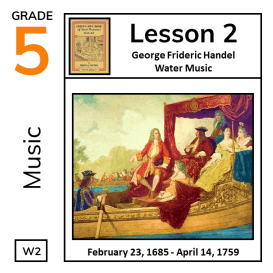
By: George Frideric Handel
Week: 2
George Frideric Handel composed 'Water Music' for a 1717 concert on London's River Thames per the request of England's King George I. The King listened to 'Water Music' from a barge on the Thames, and loved the composition so much, he asked for three repeat performances.
By: George Frideric Handel
Week: 3
'Messiah' is an oratorio written by George Frideric Handel. As it is an oratorio, it is similar to an opera, but has no costumes, acting, or scenery. 'Messiah' celebrates the role of Christianity's Jesus Christ as God's Messiah. The lyrics cover prophecies related to the coming of Jesus, his death, and his resurrection. According to [3], 'Messiah' is one of the 'best-known and most frequently performed choral works in Western music.'
By: Johann Sebastian Bach
Week: 4
The next tremendous composer is named Johann Sebastian Bach, and his story is called, "The Story of the Boy who Sang in the Streets."
The overarching Bach work featured in this lesson, "The Well-Tempered Clavier" consists of two books totaling 48 compositions across all 24 major and minor keys. The featured piece, "Prelude in Fugue No.1 in C major," is the opening composition in the first book.
By: Johann Sebastian Bach
Week: 5
The popularity of Johann Sebastian Bach's "Toccata and Fugue in D minor" soared after it was included in Walt Disney's Fantasia. The meaning of the work is controversial. Some see the music as representing a storm, but others disagree. What do you envision while listening to the piece?
By: Johann Sebastian Bach
Week: 6
August Wilhelm's transcription of Johann Sebastian Bach's Orchestral Suite No. 3 in D major, BWV 1068 is called 'Air on the G string' as the first violin part may be played solely on the G string of the violin. The G string is the thickest and lowest pitched of the violin four strings (G-D-A-E).
By: Franz Joseph Haydn
Week: 7
The next tremendous composer for study is the Austrian Franz Joseph Haydn, and the title of his story is 'The Story of the Choir Boy who became a Great Composer' by Thomas Tapper. The first Haydn work is 'String Quartet in D Major, Op.64 No.5 The Lark.' This music includes four movements: 1) Allegro Moderato, 2) Adagio, Cantabile, 3) Menuetto Allegretto, and 4) Finale Vivace. Imagine a little brown lark flying and singing its happy song, perhaps pausing to alight on the ground and hopping about before taking off again. What do you imagine the lark doing during each of the four movements?
By: Franz Joseph Haydn
Week: 8
The lesson recording incorporates the first two movements of Franz Joseph Haydn's 'Divertimento in A-flat major, Hob. XVI:46': 1) Allegro moderato and 2) Adagio. Listen for the shift in tempo during the transition from the first to the second movement. Joseph Haydn recorded this work circa 1767 and published it in 1788.
By: Franz Joseph Haydn
Week: 9
Franz Joseph Haydn composed his final symphony in 1795 while living in London. This work is the final of his twelve 'London Symphonies,' entitled Symphony No.104 in D major, 'London Symphony.' This work premiered in London at the King's Theatre and was a success. This work incorporates two flutes, two oboes, two clarinets, two bassoons, two horns, two trumpets, timpani, and strings.
By: Wolfgang Amadeus Mozart
Week: 10
The next tremendous composer for study is the Austrian composer Wolfgang Amadeus Mozart, and the title of his story is 'The Story of a Little Boy and His Sister Who Gave Concerts.' The featured composition for this lesson, 'Piano Concerto no. 21 in C major, K. 467 - II. Andante,' is one of Mozart's best known.
By: Wolfgang Amadeus Mozart
Week: 11
Wolfgang Amadeus Mozart composed "Piano Concerto no. 20 in D minor, K. 466 - Romance" in 1785. Mozart played the piece himself for its first public unveiling in Vienna, Austria.
By: Wolfgang Amadeus Mozart
Week: 12
Wolfgang Amadeus Mozart wrote his last symphony, 'Symphony no. 41 in C major 'Jupiter', K. 551' in 1788. Some critics believe 'Jupiter' is the one of the finest symphonies ever composed [2]. The symphony has four movements: 1) Allegro vivace, 2) Andante cantabile, 3) Menuetto: Allegretto, and 4) Molto allegro.
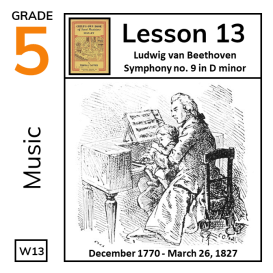
By: Ludwig van Beethoven
Week: 13
The next tremendous composer for study is Ludwig van Beethoven, and the title of his story is 'The Story of a Little Boy Who Was Forced to Practice' by Thomas Tapper. 'Symphony no. 9 in D minor, Op. 125' was Beethoven's final completed composition, written between 1822 and 1824 and premiered in Vienna, Austria. According to [2], even in the modern world, it ranks as one of the most commonly performed symphonies. Beethoven's success as a composer is especially remarkable given he had lost most of his hearing at the time he composed this work. This work contains four movements: 1) Allegro Ma Non Troppo, un Poco Maestoso, 2) Scherzo: Molto Vivace - Presto, 3) Adagio Molto e Cantabile, 4) Presto - Allegro Assai. The fourth movement includes lyrics derived from Friedrich Schiller's poem, 'Ode to Joy.' As you listen to the four movements, do you feel they were aptly named?
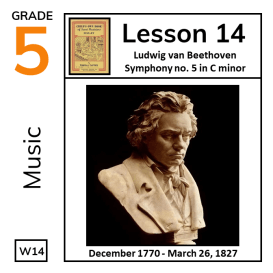
By: Ludwig van Beethoven
Week: 14
Ludwig van Beethoven composed Symphony no. 5 in C minor, Op. 67 between 1804 and 1808. It ranks along with Beethoven's Symphony No. 9 as one of the most frequently performed works in modern times. The symphony consists of four movements: 1) Allegro con brio, 2) Andante con moto, 3) Allegro attacca, and 4) Allegro. The first performance of this symphony was in Vienna, Austria. As you listen to the four movements, do you feel they were appropriately named?
By: Ludwig van Beethoven
Week: 15
Although Ludwig van Beethoven's 'Für Elise' was not found until after his death, it has become one of his most recognized compositions. Beethoven wrote this piece for solo piano. As you listen, note how the recording consists of a single person playing the piano versus an entire orchestra playing a multitude of instruments.
By: Franz Schubert
Week: 16
The next tremendous composer for study is the Austrian Franz Peter Schubert, and the title of his story is 'The Story of the Boy Who Wrote Beautiful Songs' by Thomas Tapper. The first piece is 'Piano Quintet in A major, D. 667 - IV. Andantino – Allegretto.' The fourth movement offers variations on the melody, 'Die Forelle' or 'The Trout.'
By: Franz Schubert
Week: 17
Written in the last months of this life, 'Piano Sonata no. 21 in B-flat major, D. 960' was part of the trio of compositions by Franz Schubert known as 'Schubert's Last Sonatas.' This sonata consists of four movements: 1) Molto moderato, 2) Andante sostenuto, 3) Scherzo: Allegro vivace con delicatezza - Trio, and 4) Allegro ma non troppo – Presto.
By: Franz Schubert
Week: 18
Franz Schubert composed 'Symphony no. 8 in B minor 'Unfinished', D. 759' in 1822. This symphony is 'Unfinished' since it contains two movements rather than the typical four: 1) Allegro Moderato, 2) Andante con moto. Why Schubert failed to finish the symphony is a mystery. Schubert began composing the symphony six years before his death in 1828, so had sufficient time to complete it.
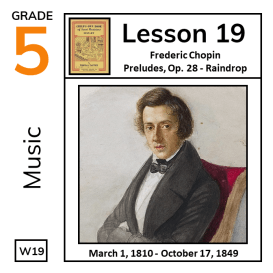
By: Frédéric Chopin
Week: 19
The next tremendous composer for study is Frédéric François Chopin, and the title of his story is 'The Story of the Boy Who Made Beautiful Melodies' by Thomas Tapper. The title of Chopin's composition featured in this lesson is 'Preludes, Op. 28 - No. 15 Raindrop.' Written between 1835 and 1839, Chopin's 24 Preludes, Op. 28, are a set of short piano compositions. If you recall, Under the Home First Grade Music Lessons 16-23 incorporated eight of Chopin's Op. 28 preludes, including 'Tolling Bells,' 'The Night Moth,' 'The Dragonfly' and 'The Duel.' If you wish, harken back for a quick review. As you listen to the composition, imagine the accompanying sounds, sights, and scents of rain pattering against an open window.
By: Frédéric Chopin
Week: 20
Frédéric Chopin wrote 'Fantaisie-Impromptu, Op. 66' in 1834 for solo piano. The composition was not published until after his death in 1855.
By: Frédéric Chopin
Week: 21
Frédéric Chopin composed his 21 solo piano Nocturnes between 1827 and 1846. The featured composition in this lesson, "Nocturne in B flat minor, Op. 9 no. 1," is the first of three nocturnes that make up "Nocturne in B flat minor, Op. 9."
By: Robert Schumann
Week: 22
The next tremendous composer for study is the German Robert Schumann, and the title of his story is 'The Story of the Boy Who Made Pictures in Music' by Thomas Tapper. Schumann's composition, 'Carnaval, Op. 9 (Little Scenes on Four Notes),' symbolizes the masked merrymakers celebrating Carnival. Carnival is the season just before the beginning of Lent. During Lent, some Christians abstain from foods and pleasures in preparation for paying tribute to the resurrection of Christ during Easter.
By: Robert Schumann
Week: 23
Robert Schumann wrote 'Three Fantasy Pieces,' or 'Drei Fantasiestücke, Op. 73,' in 1849. Although written for piano and clarinet, the featured recording includes piano and cello. The titles of the three fantasy pieces are as follows: 1) Tender and with expression, 2) Lively, light, and 3) Quick and with fire.
By: Robert Schumann
Week: 24
Robert Schumann's 'Scenes from Childhood (Kinderszenen)' includes thirteen piano pieces. The pieces are named as follows: 1) Of Foreign Lands and People, 2) A Curious Story, 3) Blind Man's Bluff, 4) Pleading Child, 5) Happiness, 6) An Important Event, 7) Dreaming / Reverie, 8) At the Fireside, 9) Knight of the Hobby Horse, 10) Almost Too Serious, 11) Frightening, 12) Child Falling Asleep, and 13) The Poet Speaks.
By: Franz Liszt
Week: 25
The next tremendous composer for study is the Hungarian Franz Liszt, and the title of his story is 'The Story of a Boy Who Became a Great Pianist and Teacher' by Thomas Tapper. 'Hungarian Rhapsody no. 2' is the second and most renowned of a collection of nineteen rhapsodies composed by Franz Liszt. An excerpt from this work is leveraged today in songs and in cartoons. You will likely recognize the tune beginning just prior to the five-minute mark of the featured recording.
By: Franz Liszt
Week: 26
Published in 1850, Franz Liszt's 'Liebesträume (Dreams of Love), S. 541' consists of three solo piano lieder. Lieder are poems set to classical music. Liszt based 'Liebesträume' on three poems featuring variations of love: 1) Religious love, 2) Ardent love, and 3) Enduring love [2]. This recording features Liebesträume No. 3, the last composition.
By: Franz Liszt
Week: 27
Published in 1854, Franz Liszt dedicated 'Sonata in B minor, S. 178' to fellow composer Robert Schumann. However, Schumann's wife, pianist and composer Clara Schumann wasn't a fan and refused to play it. Many others at the time agreed with Clara Schumann, but the popularity of the composition eventually bloomed at the turn of the century.
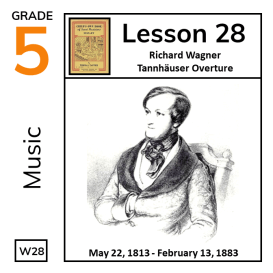
By: Richard Wagner
Week: 28
The next tremendous composer for study is German opera composer Richard Wagner, and the title of his story is 'Wagner: The Story of the Boy Who Wrote Little Plays' by Thomas Tapper. This lesson features the overture to Wagner's 1845 opera, Tannhäuser. Tannhäuser's 1861 opening in Paris, France was a failure. However, the opera's popularity grew and it is still performed today. The opera Tannhäuser concerns finding redemption through the power of love. The opera's protagonist, also called Tannhäuser, is a poet and knight who leaves the mythological subterranean abode of the goddess Venus to pilgrimage back to Earth. Back in the mortal realm, Tannhäuser seeks absolution in Rome from the Pope. The Pope rebuffs Tannhäuser, saying it'd take a miracle for Tannhäuser to earn forgiveness. When all hope seems lost, is a miracle possible for Tannhäuser or will he return to the subterranean lair of Venus? As a fun side note - some may recognize the composition from the famous Looney Tunes episode, 'What's Opera, Doc?' This episode features Elmer Fudd serenading a bewigged Bugs Bunny and alludes to multiple Richard Wagner operas, including Tannhäuser.
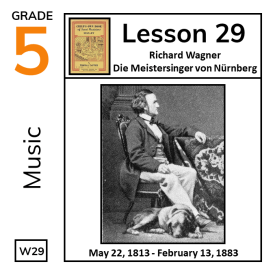
By: Richard Wagner
Week: 29
Richard Wagner completed the comic opera 'Die Meistersinger von Nürnberg WWV 96' (The Mastersingers of Nuremberg) in 1867. The opera tells the story of young knight named Walther who strives to win a song writing and singing contest that will be judged by the Mastersingers of Nuremberg. The prize for winning the contest is the hand in marriage of a lovely girl named Eva. This lesson features the overture to the opera.
By: Richard Wagner
Week: 30
Richard Wagner's opera 'The Valkyrie' (Die Walküre, WWV 86B) premiered in Munich, Germany in 1870. The featured opera excerpt is the thundering and majestic 'Ride of the Valkyries.' Imagine the mythological Valkyrie women riding into battlefields to take fallen warriors to their heaven in Valhalla.
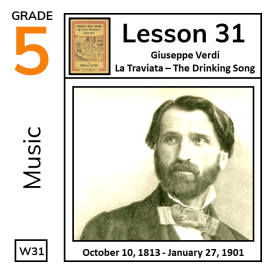
By: Giuseppe Verdi
Week: 31
The next tremendous composer for study is Giuseppe Verdi, and the title of his story is 'The Story of the Little Boy who Loved the Hand Organ' by Thomas Tapper. The first featured Verdi composition is 'The Drinking Song' from Verdi's opera, 'La Traviata.' La Traviata (English: The Fallen Woman) premiered in Venice, Italy in 1853, and it is still commonly performed today. In La Traviata, the charming but scandalous Parisian beauty, Violetta, falls deeply in love with Alfredo Germont. At the request of Alfredo's father, Violetta abandons Alfredo to avoid sullying the reputation of his family. Unfortunately, when the truth of Violetta's love is revealed and Alfredo rushes to her side, she soon after dies from an illness. In La Traviata's 'The Drinking Song,' Alfredo, who has a fine singing voice, sings to win the attention of the vivacious and witty Violetta.
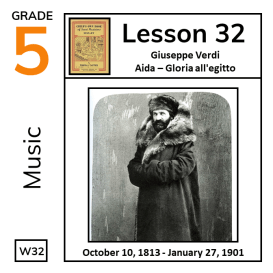
By: Giuseppe Verdi
Week: 32
'Gloria all'egitto' (Translation: Glory to Egypt) from the opera 'Aida' is the next featured composition by Giuseppe Verdi. In Aida, the Egyptians take the Ethiopian princess, Aida, captive. Not knowing Aida's true identity as a princess, the Egyptians force her into slavery. When Aida's father, king of Ethiopia, learns of her fate, he declares war on Egypt. Aida meets the Egyptian warrior, Radamès, and they fall in love. Because of the war, their love is forbidden and must remain secret. Aida and Radamès attempt to flee to be together, but they are caught. As punishment, Radamès is sealed in a tomb to perish. He's shocked to find Aida has hidden herself inside the tomb. Now they can be together at last, even if only in death. In Gloria all'egitto (Glory to Egypt), Radamès has triumphed in battle over the Ethiopians and returns to town victorious.
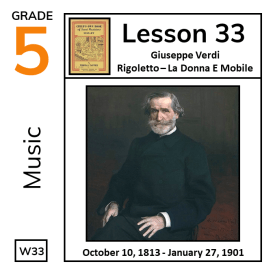
By: Giuseppe Verdi
Week: 33
Giuseppe Verdi's 'La Donna è Mobile' (Translation: Woman is Fickle) from the opera Rigoletto. In Rigoletto, an angry mother curses the Duke of Mantua and his court jester, Rigoletto, for wronging her daughter. Rigoletto's lovely daughter, Gilda, loses her life as a result of the curse. In 'La Donna è Mobile,' the Duke of Mantua laments that women are untrustworthy. However, it is the Duke's deceitful treatment of a young woman that drives the plot, leading to tragedy.
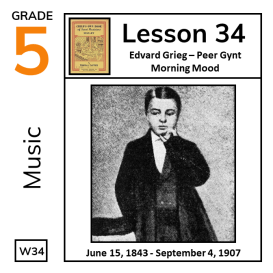
By: Edvard Grieg
Week: 34
The final tremendous composer is the Norwegian Edvard Grieg. The title of his story is 'The Story of the Boy Who Made Music in the Land of the Midnight Sun' by Thomas Tapper. 'The Land of the Midnight Sun' refers to Norway as parts of Norway are so far north the sun never sets on some summer days. Grieg based his composition, 'Peer Gynt Suite no. 1, Op. 46,' on the similarly titled play by Norwegian playwright Henrik Ibsen. The play features the wanderings of its aimless, ignoble antihero, Peer Gynt. This lesson features the first movement of the suite, 'Morning Mood.' In the accompanying scene from 'Peer Gynt' (Act 4, Scene 4), Peer Gynt's friends have abandoned him in the exotic deserts of Morocco. The play describes the scene as: 'Dawn. Acacias and palm trees. Peer [Gynt] is sitting in his tree using a wrenched-off branch to defend himself against a group of monkeys.' Peer Gynt has been adapted into multiple movies over the years.
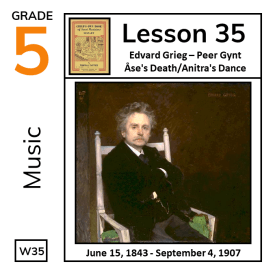
By: Edvard Grieg
Week: 35
This lesson features the second and third movements of Edvard Grieg's 'Peer Gynt Suite no. 1, Op. 46,' entitled 'Åse's Death' and 'Anitra's Dance.' In the play, Åse is Peer Gynt's mother. Norwegian playwright Henrik Ibsen based the character of Åse on his own mother. The beautiful melody captures the mournful ambiance as Peer Gynt visits his mother on her deathbed. The third movement, the upbeat, plucky 'Anitra's Dance,' corresponds to a scene in the play when the daughter of a Bedouin dances for Peer Gynt in Africa.
By: Edvard Grieg
Week: 36
The fourth and final movement of Edvard Grieg's 'Peer Gynt Suite no. 1, Op. 46,' is entitled 'In the Hall of The Mountain King.' This music accompanies the scene from the play when mountain trolls capture Peer Gynt and bring him to meet their King in his great hall.